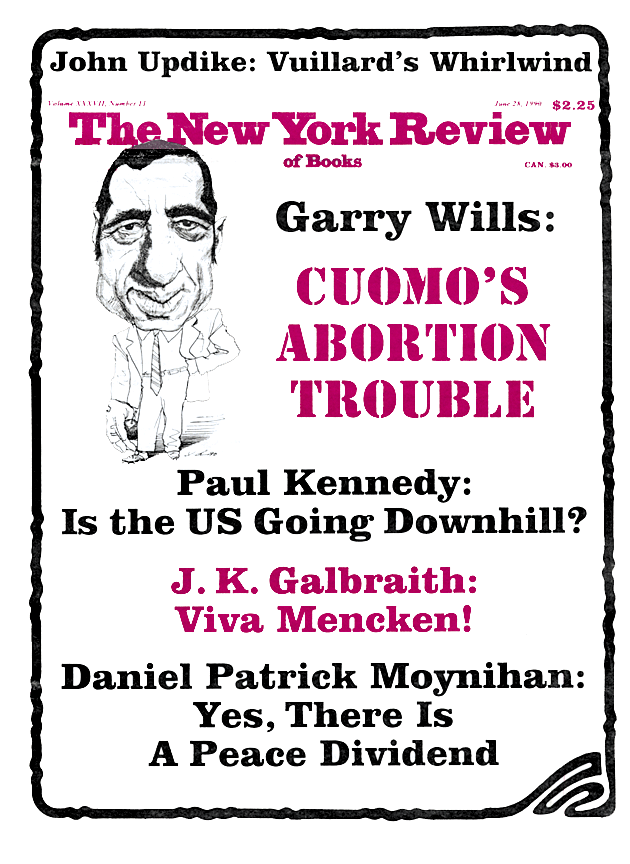In response to:
The Doctrine of Destruction from the March 29, 1990 issue
To the Editors:
As an ex-navigator in heavy bombers in the Eighth Air Force during World War II, I was much taken by Lord Zuckerman’s analysis of our bombing policy in “The Doctrine of Destruction” [NYR, March 29]. I would like to make the following comments and clarifications:
- Our technique in bombing the German cities, called pinpoint bombing, did focus on particular targets, but equally could be described as area bombing, since only the lead navigator of the squadron of planes focused its bombsight on the target. We who followed simply dropped our bombs when we saw the lead plane’s bombs falling, with the result, we were told, of the bombs falling in a pattern of a square mile around the target. Mostly, therefore, our bombs just fell into the center of cities to terrorize the populations.
- Lord Zuckerman is undoubtedly correct in stating that bombing the synthetic oil plants did not shorten the war, but one of its objectives, successfully achieved, I think, was to prevent the resurgence of Germany’s air defense, especially because the jet fighter had been developed late in the war, and was in production, and if the Germans could send up a lot of them at us, it would wreak havoc on our B-17s, which by flying in close formation until then had been pretty successful in getting the bombs to target. The fighters protecting us never could come with us all the way to the major targets in Germany. We were on our own. Luckily the war ended before the Germans built a large enough jet fighter force to knock us down.
- Toward the end of the war, in the last months, there were really limited targets left for us to hit, and there was this enormous machine faced with idleness, so we were sent on some pretty flaky raids, more to keep busy than anything else. It was in this context that the Dresden raids were, shamefully, cooked up. On one late mission, inside Germany, I remember that we had to bomb German ground forces in support of an Allied attack. Considering the unwieldiness of thousands of bombers coordinating that closely, it was indeed risky. We also bombed the submarine pens at Royan in Brittany, when the area had been mostly liberated.
In the main I agree with Lord Zuckerman’s thesis of the benefit of bombing the railroad junctions, and would like to add in his support that by destroying the railroads leading to Auschwitz it would have saved so many lives.
Edward Field
New York City
Lord Zuckerman replies:
Mr. Field’s comments on my review interested me greatly. His observation that “pin-point bombing” by squadrons of 8th Bomber Command meant in practice that their bombs fell within an estimated area of a square mile implies that the result was much the same as that achieved by RAF Bomber Command, whose aiming points in nighttime attacks on cities were indicated by marker flares dropped by pathfinder aircraft which preceded the main bomber force. Bombs falling in an area of a square mile would certainly have been regarded as area bombing.
I was also interested to read that the 8th Fighter escorts never reached as far as the major targets to which the bombers were sent, as I was under the impression that in the last weeks of the war the Mustangs did have the necessary range. But in any event, there was surely little chance by the critical last quarter of 1944 of a significant resurgence of a Luftwaffe fighter defense. German fighters were still being produced in quantity, but there was a major shortage of pilots, fuel, and training time, and by then what was left of Hitler’s air forces had more than enough on their hands in helping to stem the Russian advance. Once the counteroffensive in the Ardennes had been held, and the Allied advance resumed, the Luftwaffe was in no position to offer any significant resistance to the Allied bombing offensive.
I also agree with what Mr. Field says in his penultimate paragraph, except insofar as Dresden was included on a list of targets that had been drawn up before the German offensive in the Ardennes had been turned back. It was only after the Russians closed in and after the Allies had resumed their advance into Germany that the number of targets available for the strategic air forces became increasingly limited.
This Issue
June 28, 1990


